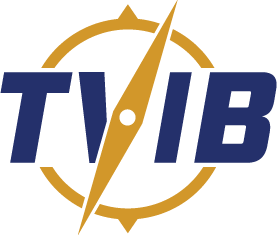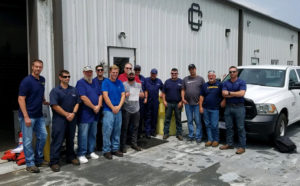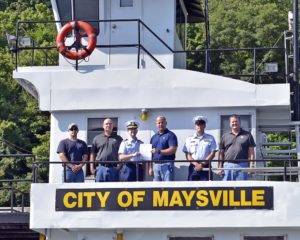Reposted from the Coast Guard Maritime Commons
08/09/2018: Recap of Coast Guard-American Waterways Operators Steering Committee Meeting
Posted by LT Amy Midgett, Thursday, August 9, 2018
The Coast Guard-American Waterways Operators Safety Partnership held its National Quality Steering Committee meeting July 31, 2018, with an agenda focusing on the concerns of the partnership and industry.
The Coast Guard/AWO partnership was formalized with a memorandum of agreement in 1995, after recognition that each organization shared the common goals of improving towing industry safety and increasing environmental protections. The partnership is a non-regulatory body that promotes sharing of best practices, waterways management and professional cooperation.
This meeting marked the first NQSC meeting since Subchapter M towing vessel regulations went into effect July 20, 2018. So far, 41 towing vessels have received an initial Certificate of Inspection, leaving approximately 5600 over the four-year phase in period.
“I’m very proud of the work done by towing vessel owners and operators, Third Party Organizations, the Towing Safety Advisory Committee, the Coast Guard Towing Vessel National Center of Expertise, our experts at Coast Guard Headquarters, and Coast Guard personnel across the nation over the last 15 years to get us to where we are today with Subchapter M implementation,” said Rear Adm. John Nadeau, assistant commandant for prevention policy, during his opening remarks. “We are not done yet, but we should all pause and acknowledge everything that’s been accomplished to successfully get us here.”
Nadeau said the Coast Guard is focused internally on its marine safety and prevention program, noting that marine inspector training, third party oversight, and a strategic outlook toward safeguarding the Marine Transportation System are early priorities for the new commandant, Adm. Karl Schultz.
Nadeau and AWO Co-Chair Tom Allegretti then led an open discussion about some of the challenges and future goals associated with Subchapter M. A few of the topics discussed included:
- The importance of TPOs’ role in achieving compliance
- The need for a standardized approach for authorizing temporary, mission-specific operations outside a tug’s established boundary line
- Improving communication with TPOs
- Incentivizing the TSMS option over the Coast Guard option
- Future Coast Guard policy addressing low risk requirements
“The Coast Guard is dedicated to ensuring TPOs succeed; their success is our success,” Nadeau said to National Quality Steering Committee members. “Owners and operators of TSMS vessels should make their TPOs their first stop for questions, and, in turn, TPOs have head of the line access to my staff at Headquarters and at the Towing Vessel National Center of Expertise.”
The meeting also included updates from workgroups and quality action teams on the progress of new initiatives and policy/regulatory implementations.
- The Subcommittee on Operational Crew Fatalities presented findings of its study on crew deaths resulting from falls overboard, which account for 48 percent of all operational fatalities on towing vessels. The subcommittee is developing a training regimen to address the issue and will present its recommendations at the AWO safety conference later this year.
- The Towing Industry Cyber Management Team presented a draft best practices guide to assist towing companies of all sizes to assess their cyber vulnerabilities and develop a risk management plan for preventing a cyber incident and how to remain resilient should one occur.
- The Fatigue Risk Management Working Group briefed attendees on a draft plan to help the towing industry manage and mitigate risk factors associated with fatigue in the unique operational and environmental challenges in which they work. The plan covers four core elements: education, environment, work readiness and fatigue reporting, and performance management. AWO expects to release the guide later this summer.
To close the meeting, Nadeau said moving forward with Subchapter M implementation, the Coast Guard will focus on three key elements: third party oversight, emphasizing the importance of using a safety management system to manage risk, and redoubling efforts to help TPOs understand their roles, responsibilities, and authorities under Subchapter M.
Click here for the original post on Maritime Commons.

 On June 27th, Crounse’s vessel the M/V Eva Kelley, was the first vessel in their fleet to receive their Certificate of Inspection (COI). Dylan Hesley, Manager of Safety, along with the shoreside team and the crew of the M/V Eva Kelley worked with MSU Paducah in submitting the required information for the COI application and getting the vessel ready for the inspection. Civilian Marine Inspector Joseph Brown said, “It is definitely a process to gather all of the required information needed for objective evidence but with constant communication between the vessel rep and the Coast Guard it can be relatively painless.” He went on to encourage companies to begin conversations with their local USCG Marine Inspectors and submit their vessel particulars as soon as possible. Submitting these details up front allows the local unit to build the vessel profile in the Coast Guard’s Marine Information for Safety and Law Enforcement (MISLE) system and move on to the step of reviewing objective evidence. Mr. Brown noted that reviewing the objective evidence takes considerable time on their part. TVIB recommends contacting each unit where a company will apply for a COI to determine their specific requirements as the USCG has not adopted a single standard. This was the first COI issued by Marine Safety Unit Paducah.
On June 27th, Crounse’s vessel the M/V Eva Kelley, was the first vessel in their fleet to receive their Certificate of Inspection (COI). Dylan Hesley, Manager of Safety, along with the shoreside team and the crew of the M/V Eva Kelley worked with MSU Paducah in submitting the required information for the COI application and getting the vessel ready for the inspection. Civilian Marine Inspector Joseph Brown said, “It is definitely a process to gather all of the required information needed for objective evidence but with constant communication between the vessel rep and the Coast Guard it can be relatively painless.” He went on to encourage companies to begin conversations with their local USCG Marine Inspectors and submit their vessel particulars as soon as possible. Submitting these details up front allows the local unit to build the vessel profile in the Coast Guard’s Marine Information for Safety and Law Enforcement (MISLE) system and move on to the step of reviewing objective evidence. Mr. Brown noted that reviewing the objective evidence takes considerable time on their part. TVIB recommends contacting each unit where a company will apply for a COI to determine their specific requirements as the USCG has not adopted a single standard. This was the first COI issued by Marine Safety Unit Paducah. On July 13th, the M/V City of Maysville was the second Crounse vessel to receive a COI. Mike Kidd, Port Captain, worked with the vessel’s crew and MSU Huntington to obtain the vessel’s COI. U.S. Coast Guard Commander Paul Mangini had this to say “The Coast Guard appreciates the dedication, diligence and willingness of the Crounse Corporation to put the effort in to achieve compliance with Subchapter M and supply the necessary information in order to generate the first Certificate of Inspection for the City of Maysville in the Port of Huntington/Tri-State zone. We look forward to continued cooperation as we both work together to bring the rest of their towing vessel fleet into inspected status.” This was the first COI issued by Marine Safety Unit Huntington.
On July 13th, the M/V City of Maysville was the second Crounse vessel to receive a COI. Mike Kidd, Port Captain, worked with the vessel’s crew and MSU Huntington to obtain the vessel’s COI. U.S. Coast Guard Commander Paul Mangini had this to say “The Coast Guard appreciates the dedication, diligence and willingness of the Crounse Corporation to put the effort in to achieve compliance with Subchapter M and supply the necessary information in order to generate the first Certificate of Inspection for the City of Maysville in the Port of Huntington/Tri-State zone. We look forward to continued cooperation as we both work together to bring the rest of their towing vessel fleet into inspected status.” This was the first COI issued by Marine Safety Unit Huntington.